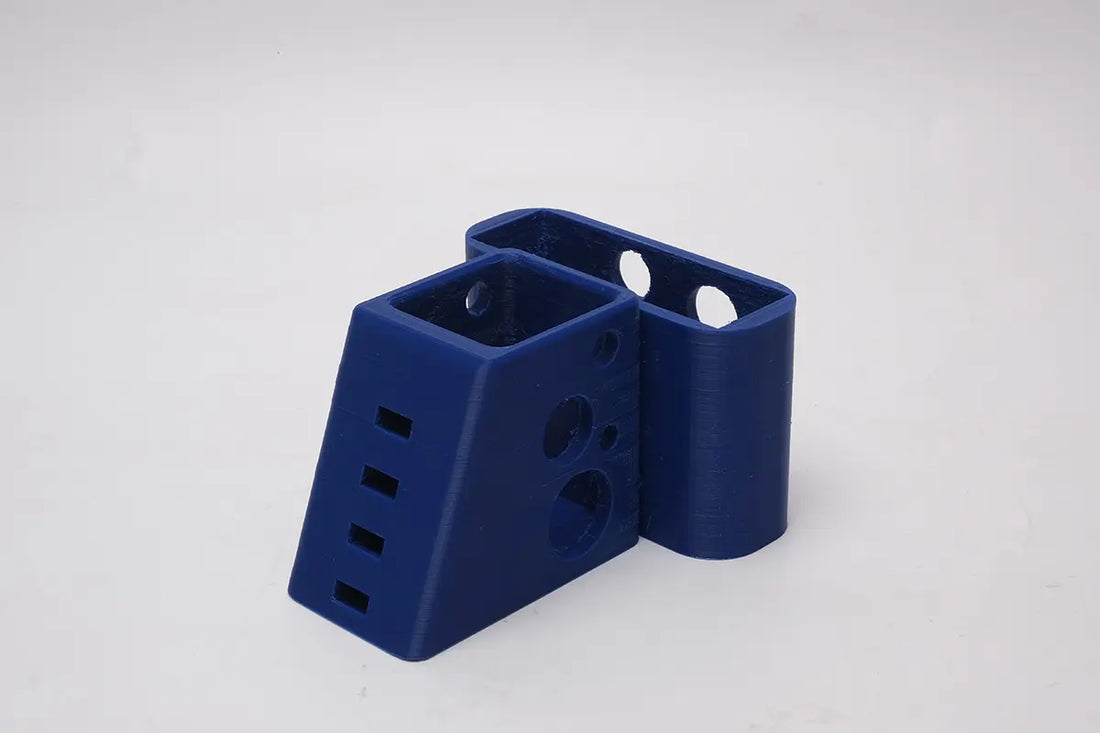
PETG (Polyethylene Terephthalate Glycol)
Share
PETG is a popular 3D printing filament known for combining the ease of printing seen in PLA with the durability and strength of ABS. It is a glycol-modified version of PET, which makes it more flexible and less prone to brittleness. PETG offers excellent chemical resistance, making it suitable for various functional applications.
Common Uses:
- Functional parts
- Mechanical components
- Consumer products
- Outdoor applications
- Containers and bottles
PETG Variations:
PETG+
PETG+ is an improved version of standard PETG, typically offering better impact resistance and printability.
It’s great for parts that require more toughness, especially in functional or load-bearing applications.
PETG CF (Carbon Fibre)
This variation incorporates carbon fibres, making the filament significantly stiffer and stronger, with a higher strength-to-weight ratio.
It’s ideal for structural parts or components that need to be lightweight yet strong.
PETG Matte
PETG Matte produces a more subdued, matte finish, reducing the glossy appearance that’s typical of regular PETG.
This material is perfect for applications where aesthetics matter, and a less shiny finish is desired.
Transparent PETG
PETG in a transparent formulation offers excellent clarity and optical properties, making it ideal for parts requiring transparency.
It can be used in cases, containers, or any print requiring see-through characteristics.
PETG Variations Comparison Table
|
Material |
Strength |
Flexibility |
Heat Resistance |
Surface Finish |
Common Applications |
|
PETG |
High |
Moderate |
Medium (~80°C) |
Glossy |
Functional Parts, Containers |
|
PETG+ |
Very High |
Moderate |
Medium (~80°C) |
Glossy |
Load-bearing Parts, Mechanical Components |
|
PETG CF |
Very High |
Low |
Medium (~80°C) |
Slightly Matte |
Lightweight Structural Parts |
|
PETG Matte |
High |
Moderate |
Medium (~80°C) |
Matte |
Aesthetic Parts, Functional Components |
|
Transparent PETG |
High |
Moderate |
Medium (~80°C) |
Glossy/ Transparent |
Containers, Light Fixtures |
Pros and Cons of PETG
Like all filaments, there are pros and cons to using PETG and its variations.
Pros:
- Durable and impact-resistant: PETG is tougher and more flexible than PLA, making it ideal for functional parts.
- Chemical resistance: It holds up well against a variety of chemicals, including water, solvents, and acids.
- UV-resistant: PETG is more resistant to UV exposure than PLA, making it suitable for outdoor use.
- Easy to print: Similar to PLA, PETG is relatively easy to print with minimal warping and good adhesion to the print bed.
- Less brittle than PLA: PETG offers a good balance of flexibility and strength, making it less prone to cracking.
Cons:
- Stringing issues: PETG tends to string more than PLA due to its viscosity, requiring optimised retraction settings.
- Lower detail resolution: PETG doesn’t always capture fine details as sharply as PLA, particularly on smaller prints.
- Less rigid than ABS: While durable, PETG is still less stiff compared to ABS or Nylon.
- Bed adhesion issues: If not properly set, PETG can adhere too strongly to certain bed surfaces, sometimes damaging them.
Storage Tips:
PETG, like PLA, is hygroscopic. This means it absorbs moisture from the air, which can negatively impact print quality. Here are some tips to store it properly:
- Store in an airtight container with desiccant packs to keep moisture out.
- Use a filament dryer if you’re printing in a humid environment or after long storage periods.
- Dry before printing if the filament has absorbed moisture (using a filament dryer or low-temperature oven at around 60°C for a few hours).
Environmental Considerations:
PETG is a recyclable plastic, though it may not be accepted in regular home recycling programs. Some key considerations:
- Recyclable but not biodegradable: Unlike PLA, PETG is not biodegradable. However, it can be recycled in appropriate facilities.
- Long-lasting: PETG is more durable and resistant to environmental factors than PLA, making it a better option for long-term or outdoor applications.
- Chemical resistance: Its resistance to chemicals makes PETG a less eco-friendly option compared to PLA, though it can last longer in use.
Generic Print Settings for PETG:
Extruder Temperature: 220°C – 250°C
Bed Temperature: 70°C – 90°C
Print Speed: 30 – 60 mm/s (slower speeds help with better adhesion and detail)
Bed Adhesion: Blue tape, glue stick, or PEI sheets work well, but PETG can stick too firmly to glass or PEI without a separating layer like glue stick
Cooling: Partial cooling fan use; full cooling may weaken layer adhesion
Retraction: 3 – 6 mm at 30 – 45 mm/s to reduce stringing
Print settings can vary between filaments. Always check the manufacturer’s recommended settings on the spool’s packaging or the supplier’s website before starting your print.
Need PETG for your project? Shop RAW3D’s full range here.